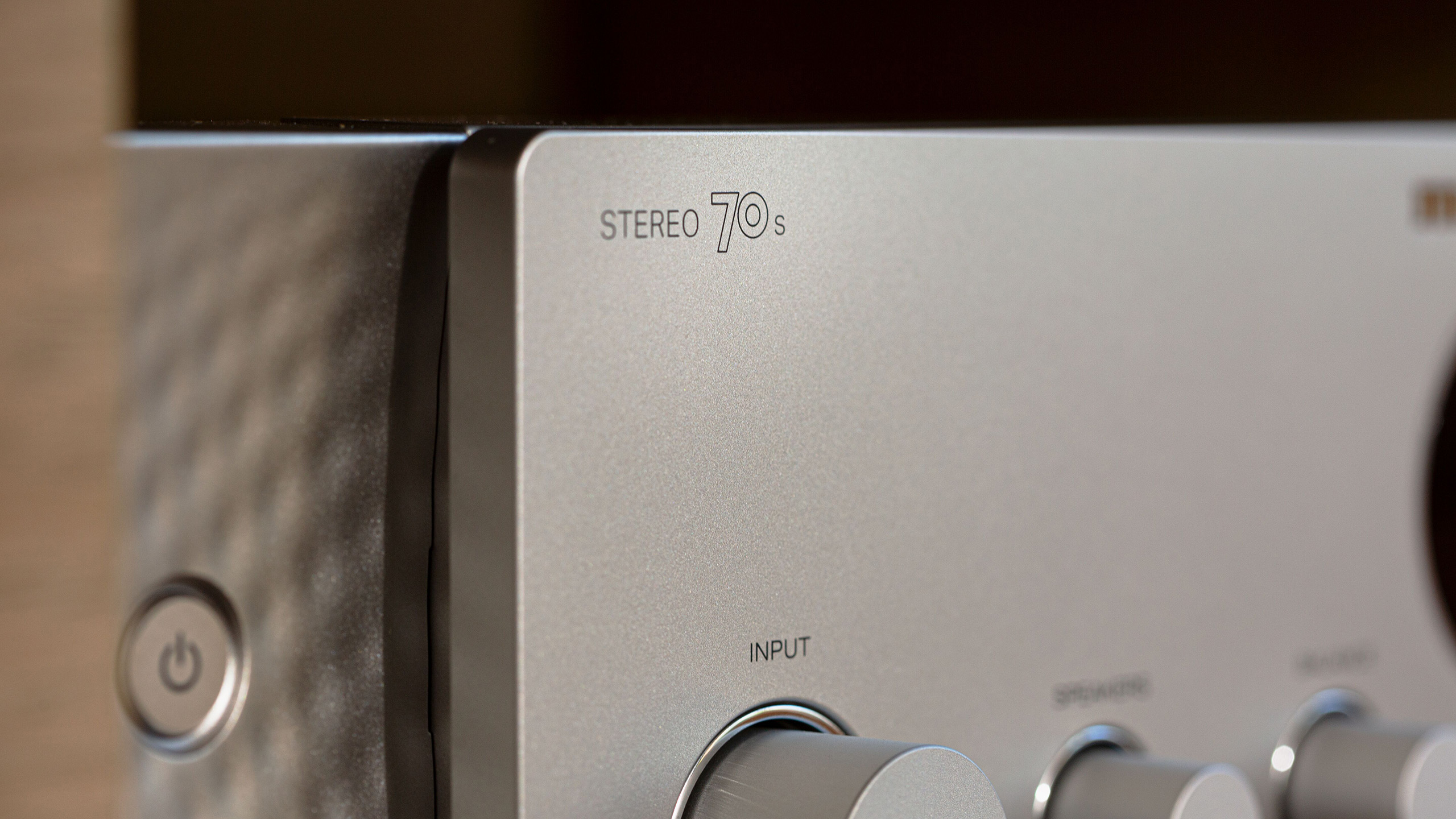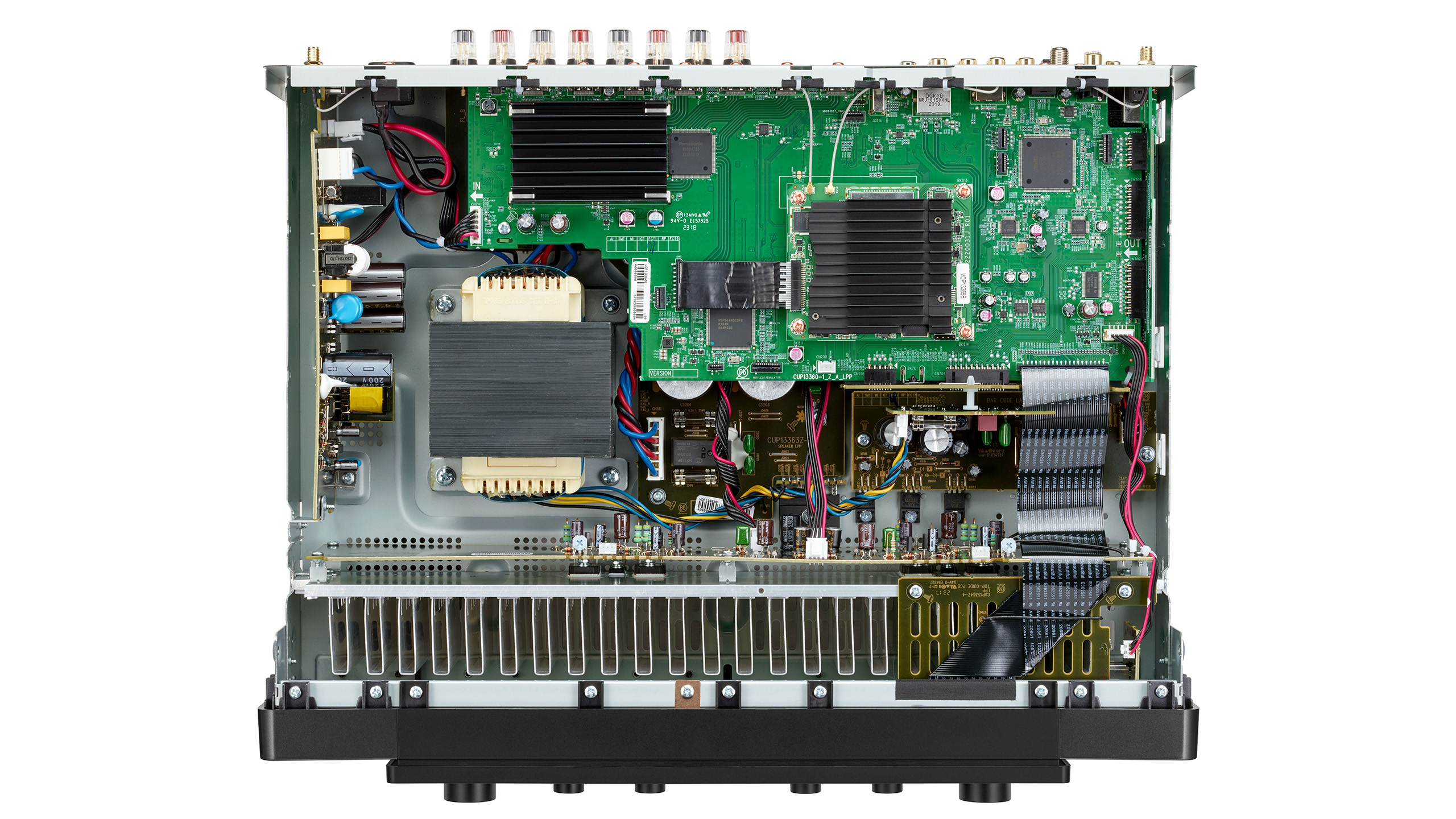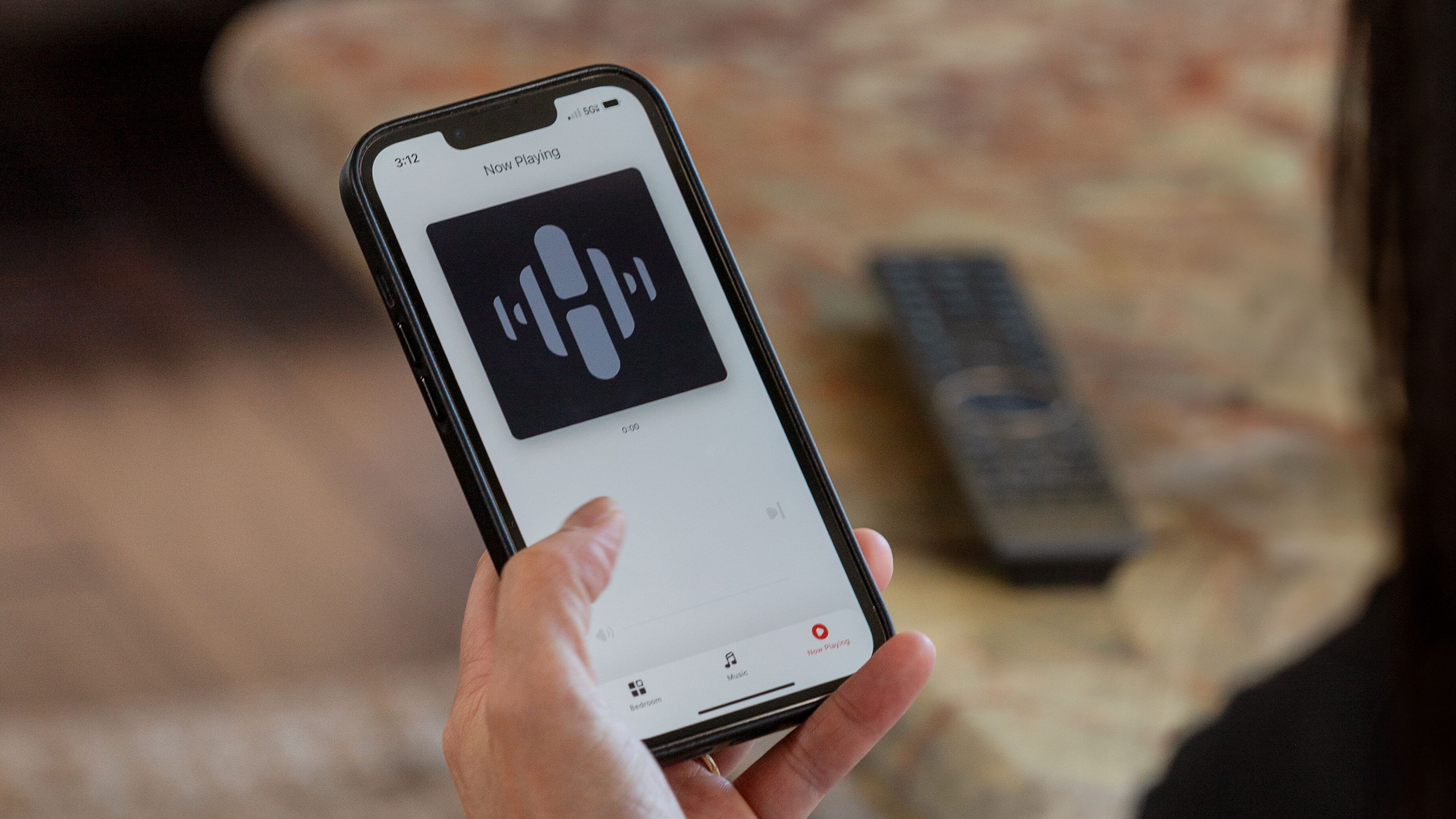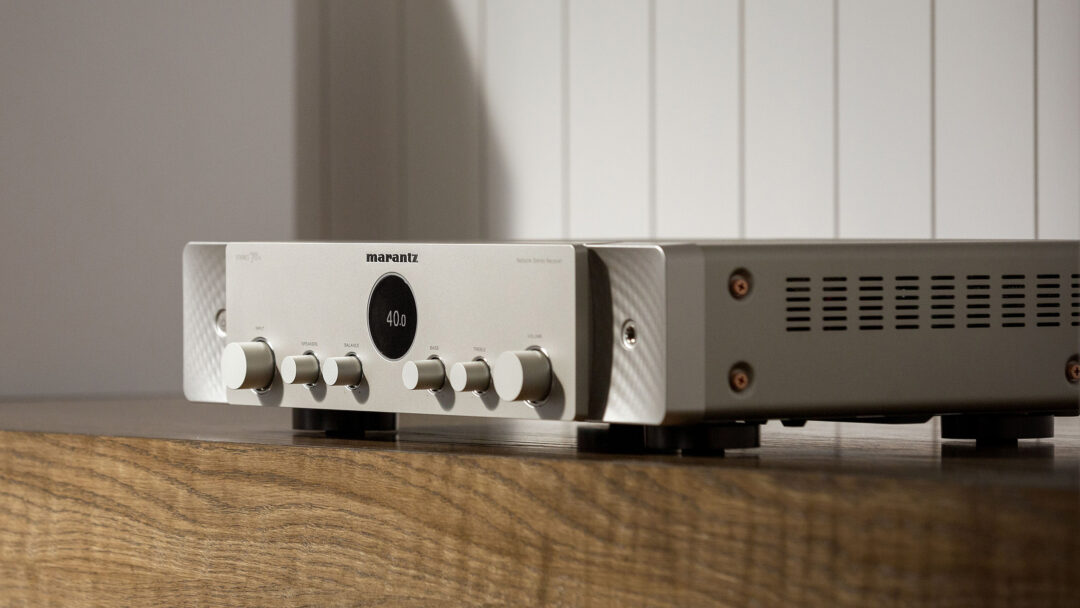So you want an amplifier? Should it be for hi-fi or home cinema?
Although both applications should, in principle, be about good sound, the lines are drawn very clearly. So much so that in many hi-fi forums, mentioning the word “surround” can be cause for banishment.
The Marantz Stereo 70s may be a bridge between the warring parties. As the name suggests, it’s a stereo receiver. And “70s” means it’s part of Marantz’s anniversary series, which marks 70 years since Saul Marantz founded the company in 1953. There is also a pure home cinema receiver in the same series and identical design, called Cinema 70s. But here we look at the stereo model.

Half of each
The Marantz Stereo 70s looks like the result of a heated affair between a home cinema receiver and a classic hi-fi amplifier. And it has inherited the input section with plenty of HDMI inputs and streaming capabilities from one parent and a good old-fashioned class AB output stage from the other. Output power is rated at 2 x 75 watts into 8 ohms.
The Stereo 70s is a low and compact unit in a design that can only be called classic Marantz: the front panel is divided into two levels, the cabinet has rounded edges and a round “porthole” in the centre of the front shows what’s going on.
The NAD C 3050 LE is a near-perfect replica of the amplifier that defined NAD design. Is this just new wine in old bottles?
Attention to detail
For such an inexpensive receiver, there’s a surprising amount of attention to detail: The front panel is completely symmetrical with two large knobs for input selection and volume and four smaller ones for speaker selector, balance, bass and treble adjustment. I can’t remember the last time I’ve seen a speaker switch or, for that matter, a balance control. But it’s super snazzy.

The round OLED display is well thought-out and elegant, and the text is exactly the same champagne gold colour as the front panels on Marantz’s classic models.
Another nice touch is the speaker selection, which is done with a clear and confident relay click for each position of the switch. Marantz could certainly have found a quieter relay for the job, but it wouldn’t have sounded nearly as convincing.
Plenty of options
The rear panel is packed with the largest selection of inputs and outputs I’ve seen in this price range: six HDMI inputs, three of which support 8K video, three analogue line inputs and a turntable input. Plus coaxial input and optical Toslink. On the output side, it’s almost as lavish: Two sets of speaker outputs, two subwoofer outputs, a set of Pre Out for an external stereo amplifier and a “Zone 2” that allows you to send the sound to another room. There are also two built-in antennas for Bluetooth and Wi-Fi, as well as an old-fashioned antenna input for FM radio. This is a real receiver.
In addition to the physical inputs, the Marantz Stereo 70s has everything you need for wireless streaming, including most relevant streaming services via HEOS. But only most of them. Apple Music and Qobuz are missing from the list. There is also no support for MQA, but with Tidal’s switch to the Flac format, this will be less of an issue in the future.

Setting up: You need the TV for this!
With so many inputs and outputs, as well as networking and streaming, it’s obvious to use the TV to set up the Marantz Stereo 70s. In principle, you can set it all up via the porthole display on the front. But that’s about as much hassle as painting the hallway through the front door letterbox!
With on-screen menus on the TV to help, the setup is much more user-friendly. And Marantz deserves extra credit for including a super-educational and simple wizard function that can explain speaker setup (and cable stripping) to even the absolute hi-fi novice.
New network player with CD and an integrated amplifier.
The HEOS mobile app isn’t quite that accessible. Even after using it for several years, I still lose my way in the app at times! This is where Marantz (and Denon, part of the same group) could learn some usability lessons from Sonos and Bluesound.
Within an hour or so, however, I had all the functions and signal sources set up on the Marantz Stereo 70s, as well as integrating it into the multi-room system. And then I could settle in to listen to music.

Sound quality
Marantz is known for its sound ( and they’re keen to emphasise it). And the Stereo 70s does not disappoint.
The sound is warm and appealing, and easy to fall in love with. The bass is solid and round – and in no way subdued. It makes you want to play more music – and turn it up a little bit louder.
Fierce dynamics
Which you can safely do. Even though the output power is a moderate 75 watts, the dynamics are surprisingly good. In fact, I’ve never before experienced an amplifier in this price and weight class delivering so much bottom-end punch on Johann Strauss’ “Banditen Galopp” – in the Telarc version, of course, where you duck for the whiplashes and jump in your seat when the timpani thunder.
If you need streaming on your system, Bluesound Node X is the perfect solution. And now with an even better DAC.
Away from the gags and pranks department and with slightly less effects-oriented tracks on the programme, more nuances are revealed. Leaving aside the price, you could wish for a little more nuance and resolution at the top. The Marantz Stereo 70s paints quite a nice and deep acoustic scene, but the stereo perspective isn’t as wide as on more expensive amplifiers and there isn’t as much air between instruments.
Less spaciousness
Afenginn’s Skjälvtin opens with a really well-recorded acoustic piano. It still sounds nice here, but the sense of being present in a large and vibrant space is toned down.
The treble reproduction is mostly fine, but voices can have a slightly sharp edge that isn’t usually present on the recording.
However, these are all minor trends, and realistically, you should expect to pay double or more to make these kinds of demands on an amplifier – at least if you expect them to be met. Most people, on the other hand, will be entertained by the solid bass and great dynamics that will keep the party going. And the sound image will work just as well in your home theatre. In stereo, that is.
Conclusion
The Marantz Stereo 70s is an unusual design that gives us all the comforts of a home cinema receiver and a “real” class AB output stage. On the other hand, you’ll have to make do with stereo sound for films. Because there is no way to expand the number of channels on Stereo 70s. But how many of us have the patience to fill the living room with speakers and run half a hundred metres of cable?
The Marantz Stereo 70s is a very successful receiver with many features at a very reasonable price. Measured by hi-fi standards, it performs very well with a warm and dynamic reproduction that is easy to love and that many will associate with classic Marantz sound. The treble can be a bit harsh at times, and the depth perspective could be bigger. But not in this price range. If we were to point to an immediate competitor in full format, it would have to be Marantz itself in the form of the Marantz NR1200, which does not have the same dynamic range. Bluesound Powernode (N330) has just as many streaming options as Marantz, but lacks the nice cabinet and physical controls.

We think
Genuine class AB amplifier. Multiroom and plenty of streaming. Six(!) HDMI inputs. Charming design. Dynamic and likeable sound. No surround sound option. For the lazy home cinema owner, a soundbar is still easier. Slightly harsh treble.
999 €
Specifications
- Output power: 2 x 75 W Class AB (8 ohm)
- Analogue inputs: Turntable (MM, stereo RCA), 3 x analogue in (stereo RCA)
- Digital inputs: Optical (TosLink), Coaxial, 6 x HDMI (3 of which with 8K support), USB-A, Ethernet
- Outputs: 2 sets of speakers (banana/screw terminals), zone 2 (stereo RCA), pre out (stereo RCA), 2 x subwoofer, 1 x HDMI
- Wireless: FM radio, Wi-Fi, Bluetooth, AirPlay 2
- Streaming (HEOS): Tidal, Spotify Connect, Deezer, Amazon and more Roon.
- Resolution: Up to 24-bit / 192 kHz
- Formats: FLAC HD, WAV, ALAC, DSD 5.6 MHz, AAC, MP3, WMA
- Room correction: No
- Remote control: Remote control, HEOS app, Marantz AV app
- Dimensions and weight: 44.2 x 10.9 x 37.4 cm (WxHxD) / 7.9 kg
- Web: marantz.com



